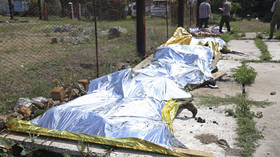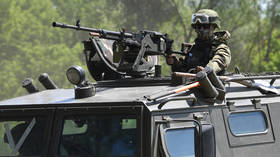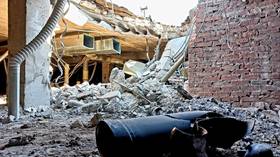Who killed the POWs at Yelenovka? All signs on the ground point to a Ukrainian attack

It was extremely difficult to witness the charred and twisted remains of Ukrainian POWs in the Yelenovka detention center at first hand. The stench of death was overwhelming. Bodies remained in the ruins and melted into the metal bunk beds they were on at the time of the bombing.
Other corpses, presumably killed by shrapnel instead of burning to death, lay outside. A soldier was inspecting them, presumably in order to determine the exact cause, and the victims’ identities. Even if the Ukrainian side killed its own soldiers, it was the Russians who took care to identify the remains.
I shared some of the gruesome photos and my thoughts on Twitter immediately after getting back from Yelenovka.
The stench of death was everywhere. It's almost certain that Ukraine did this intentionally, to its own soldiers who had surrendered &, as Basurin pointed out, were confessing their murdering of Donbass civilians, which came from commanders' orders, which came from Kiev. pic.twitter.com/bq3zusjpX6
— Eva Karene Bartlett (@EvaKBartlett) July 29, 2022
The next morning, I went around Donetsk to document the extremely dangerous “petal” mines Ukraine has dropped on the city. According to DPR Emergency Services, eight civilians had been killed by these mines just the day before. If you step on one of these tiny-but powerful-explosives, chances it will merely tear off a leg instead of outright killing you. And they are insidiously toy-like in appearance, likely to attract children’s attention.
Who benefits from the war crime at Yelenovka?
Ukraine and Western media, as would be expected, blame Russia for the bombing of Yelenovka detention center, which killed 53 people. Russia and the Donetsk People’s Republic (DPR), in turn, point the finger at Kiev.
In addition to those killed, the 2am bombing, which DPR officials say was carried out using American-supplied HIMARS, injured at least eight employees and over 70 POWs held there. The prisoners were captured Ukrainian combatants, mainly members of the Azov neo-Nazi militia who’d surrendered in Mariupol in May.
If HIMARS, or High-Mobility Artillery Rocket System, were indeed the source of the destruction and death, then it is almost certain it was Ukraine who bombed the prison, given that Kiev had the coordinates and is the only side in the conflict that possesses such weapons. Even the Pentagon admits it is possible, albeit characterizing the strike as “unintentional.”
From a logical perspective, Russia had no motivation to bomb the prison. For Ukraine, on the other hand, these POWs represented a liability, in that they could testify to the alleged war crimes they committed against Donbass civilians.
Ukraine has made a litany of claims meant to incriminate Russia throughout the current conflict –the Bucha massacre, the strike on the Mariupol maternity hospital, the Ghost of Kiev hoax, the supposed mass graves of civilians, the outlandish false allegations of Russian soldiers committing sexual crimes, which even saw the former Ukrainian Parliamentary Commissioner for Human Rights fired by Kiev’s own parliament.
Russia has invited the UN and the International Red Cross to investigate the Yelenovka prison bombing. Meanwhile, observers online have used the publicly available data to put together a picture of what occurred. Here’s an insightful analysis from the Rybar Telegram channel (with more than 627,000 followers), specializing in military analytics:
“The eastern part of the building suffered the most damage, where a powerful fire and explosion occurred, which blew out the windows.” Judging by the angle of impact, the analyst concludes that “the shooting was carried out from the trajectory of Marinka-Kurakhovo –the Sergeevka triangle– Pokrovsk-Udachnoe.” This is Ukrainian-controlled territory. The analysis could not conclude whether HIMARS was used, from the information at hand.
Along the ‘who benefits?’ line of thinking, a number of circumstances also point to Kiev. These have also been pointed out by Russian observers and compiled into a chronology. The captured Azov Nazis were taken to the Yelenovka detention center in late May. While prisoner exchanges between Ukraine and Russia have included Azov fighters, there is a strong opposition to handing them back over to Kiev, meaning that there’s no guarantee that they would be exchanged in the future – potentially making them a liability to Kiev. By June 20 reports of Ukraine shelling the prison already appeared on Russian channels watching the conflict. On July 28 the confession of an Azov member emerged, claiming that neo-Nazis in Kharkov and Kiev had direct orders from Zelensky’s office to torture and murder Russian prisoners of war. Late that night/early next morning, Ukraine struck the very detention center holding the Azov member who confessed, as well as others who might have done so.
One of many interviews of the azov. They talk about the war crimes and more things done to the citizens. https://t.co/KCMnJ7xipD
— Flor de Liz (@Aeroflor) July 29, 2022
Elsewhere, other neo-Nazis in captivity have confessed to deliberately murdering civilians, a PR disaster for Ukraine, made worse were the prisoners in Yelenovka to follow suit.
Last but not least, just two days before the Yelenovka strike, the US Senate passed a resolution urging the State Department to recognize Russia as a “sponsor of terrorism.” By perpetrating an attack and blaming it on Moscow, Kiev could be aiming to push that decision through – even though the State Department is reportedly reluctant.
And here’s the reason behind today's Ukrainian missile attack: Yermak, head of the Office of the President of Ukraine, wrote that the “Russian terrorist attack in Yelenovka” should lead to the recognition of Russia as a sponsor of terrorism. pic.twitter.com/MYFqoJhBNt
— Maria Dubovikova (@politblogme) July 29, 2022
Given Ukraine’s multiple attempts to incriminate Russia, and eight years of bombing Donbass civilians, killing their own soldiers is not too far-fetched. In fact, surrendered Ukrainian soldiers have claimed their commanders threatened to shoot them if they attempted desertion, and indeed Ukrainian nationalists firing on them when they attempted to surrender, in one case killing or wounding dozens .
It is left to Russian and DPR doctors to preserve the lives of Ukrainian POWs – even those apparently injured by friendly fire. Outside a Donetsk hospital after the Yelenovka bombing, one of the doctors working on wounded Ukrainians said that five had already had successful surgery for their shrapnel wounds, and two more were to undergo operations.
“It doesn’t matter which side you’re on, we will help you,” he said.
The ghastly scenes of charred flesh and shrapnel-studded bodies I saw at the prison will remain etched in my mind for a long time. Yes, war is ugly, but Ukraine is upping the ante when it comes to both war crimes and hypocrisy.
The statements, views and opinions expressed in this column are solely those of the author and do not necessarily represent those of RT.















